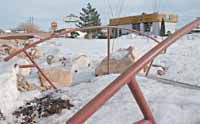| Improvements at the Creekview Shopping Center represent one of the projects partially funded with Price city RDA revenues. The local taxation board voted to discontinue the Price redevelopment district next year. |
During a taxation board meeting last Thursday, Mayor Joe Piccolo pointed out that redevelopment agency funds have been so popular with businesses in the downtown area in recent years that the city “usually gets more request for dollars than they have to give.”
But when the meeting concluded, the taxation board that regulates the RDA for the downtown area of Price voted 6-2 to eliminate the district next year.
“It’s a sad day for Price,” said the mayor Friday. “With that money extended another five years, we could have finished up a lot of what has been started downtown.”
The Price redevelopment district was formed in 1980, a time when the area of the city was considered blighted despite the fact that the economy had been improving.
Carbon County, the school district, water conservancy district and the state board of education agreed to a 25-year RDA program to put property tax monies collected in the area back into business start-ups and renovations.
The boundaries of the RDA under discussion at the Jan. 29 meeting extend from approximately 100 North to 100 South and from Castle Rock Shopping Center at about 900 East Main to the Creekview Shopping Center near the west Price exit from U.S. Highway 6.
“I get very concerned about the school district’s monetary position,” said Kathy Dudley, the representative from the state board of education. “The revenues in the county have not kept up with the needs of the district. This money that has been diverted is another pot the district can use to fund their system.”
However, the city presented a good case before the vote and, at times, it seemed the board might extend the zone.
Price city community director Nick Tatton made a presentation that laid out the achievements that have taken place in the area assisted by the money from the RDA.
“If this isn’t renewed it limits the possibilities for what can be done in the area,” he told the board.
In the past few years the RDA money helped several businesses in the area, including Office Etc., Southeast Paint and Wallcovering, Rocky Mountain Home Health, Far West Bank and Decker’s Bicycle. Money from the fund was also instrumental during the 1980s in helping with the Creekview Shopping Center construction.
However, the taxation board members were not convinced that the money would have made much difference in whether the businesses expanded or opened.
“I just have to wonder what percentage of the projects outlined would have gone ahead without the money anyway,” commented Dave Anderson, representing the water conservancy district at the meeting.
However, the Price mayor pointed out several examples where he thought the money did make a difference.
Piccolo also stated that the money is important toward the goals of the community as much as the RDA funding is to get businesses going.
“Perhaps all of them would have built without the money, but this has presented a business friendly attitude toward them from all the taxing entities involved,” stated the Price mayor.
Money from the city’s RDA fund has helped to complete public projects like Heritage Park, the Peace Garden, and landscaping near Creekview Shopping Center along 100 North, added Tatton.
The information brought comments from the group concerning infrastructure improvements in the city being funded by redevelopment money.
The money used for infrastructure was for direct improvements for businesses such as trip and fall hazards, asserted Piccolo.
How the RDA money had been distributed was another issue the taxation board members questioned during last Thursday’s meeting.
“The money was reimbursement based,” pointed out Piccolo. He also told the group that applicants for the money could get from $500 to $15,000, depending on the size of the project and other factors.
But despite the strong presentation from the city and a proposal for them to take less money per year than in the previous 25, other members of the taxation board weren’t convinced.
The idea of the RDA is not only development for the area to increase the tax base, but also to get people to start or grow businesses that will hire people. That in turn provides other taxes and also increases enrollment for the school district, which also adds up to more money from the state for higher enrollment.
“The school district’s enrollment peaked at 5000 and now it is down to about 3400 students,” said County Commissioner Bill Krompel who was one of the county’s representatives on the taxation board. “The district has lost 50 to 80 jobs since 1995 and that translates into more lost revenue and population as well.
Superintendent David Armstrong, one of the two representatives from the school district, pointed out that the schools lost 240 students this year alone.
The discussion then turned to jobs that could be added by the growth of businesses, but some of the members were unconvinced that the money had any real impact on that aspect of development.
In the end the only two members of the board that voted to extend the RDA were Price City’s representatives.
The change in where the taxes in the area go after the RDA shuts down next year means the county will collect approximately another $25,000 a year and the school district will garner around $100,000.
Presently there are four other RDAs in the county, one of which is also located within the Price City limits on the east side of town encompassing the revamped Joy Manufacturing building (now owned by Tram Electric) and onto Main Street.

